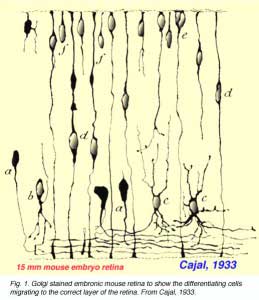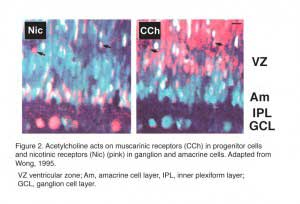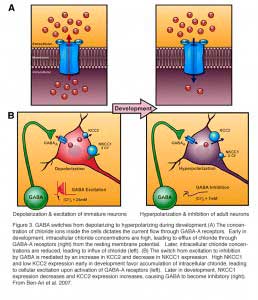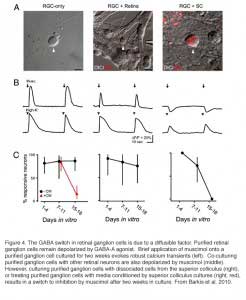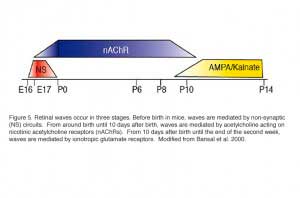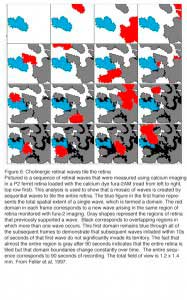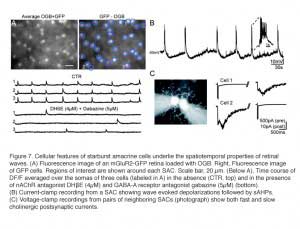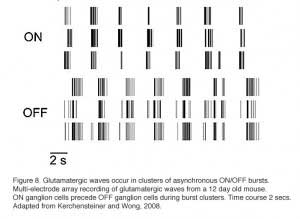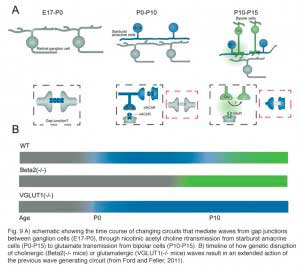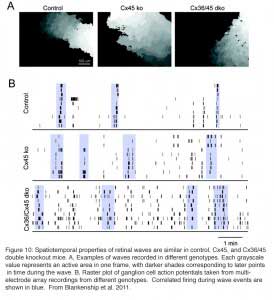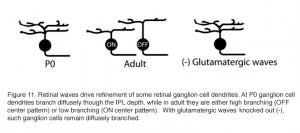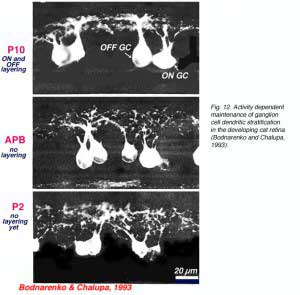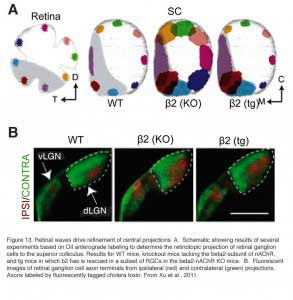Introduction
The mammalian retina has long been a model system for study of development of neural circuits in the CNS because the adult network is well organized into cell-type specific layers, and the anatomy, physiology and function of many of the retinal cell types is well characterized. A major focus of research in the retina is directed toward understanding how functional circuits arise during development.
The development of the retina requires several steps. The first step is to create the right proportion of the 7 cell types that comprise the retina. This process occurs primarily through genesis of the correct number of each cell type. Only ganglion cells have their final number regulated by cell death, which reduces the number of ganglion cells by as much as 50% in some species. The second step is for cells to migrate into the correct location. The third step is for neurons to form synaptic connections with other retinal neurons. Finally, for some of these groups of synaptically coupled cells, synaptic refinement is necessary to generate the circuits that comprise the adult retina.
The process of neuronal migration in the retina has been the focus of developmental biologists since the time of Cajal, who used Golgi staining techniques (Fig. 1). Progenitor cells in the neurepithelium lining the surface of the neural tube later become the ventricular zone of the optic vesicles, optic cup and early retina. Postmitotic cells leave the ventricular zone to migrate to one of three cell layers in the retina remaining attached radially from one side of the retina to the other. The neural cells lie at different levels in the retina and, when in correct position, lose their anchoring radial connections. Then polarity of the differentiating cells occurs and dendrites and axons grow out appropriately. The ganglion cells are the first to emerge as recognizable neurons with axons passing to the optic nerve and central brain structures (Fig. 1a and b). Then amacrine cells (Fig. 1c), Muller cells, bipolar cells (Fig. 1d), and horizontal cells form in the correct layer and finally photoreceptors remain to line the top layers (Fig. 1e and f).
Before the neural circuits that underlie visual processing emerge, the retina assembles and disassembles a series of intermediate circuits. These transient connections between cells produce the propagating spontaneous activity that is termed retinal waves (Meister et al., 1991; Penn et al., 1994; Feller et al., 1996). As the retina develops, so do the circuits that underlie retinal waves. The earliest spontaneous retinal waves are propagated via electrical coupling between cells. Then, around birth in mice, waves are produced by a transient network consisting of cholinergic connections between amacrine cells. Finally, just before visual processing begins, they are driven by early glutamatergic signaling.
In this chapter we will discuss how these transient circuits of the inner plexiform layer (IPL) assemble to produce specific patterns of neural activity, and how they transition from one circuit into the next. Finally, we will discuss the role of spontaneous activity in shaping the development of the visual system within both the retina and the brain.
Neurotransmitters and Early Retinal Development
Early in development, neurotransmitters can function in the absence of traditional synapses (Redburn and Rowe-Rendleman, 1996). Ultrastructurally identified conventional synapses within the IPL are first formed a few days after birth in mice (Fisher, 1979). However, even before that there is evidence of neurotransmitters. Below we discuss the role of early neurotransmitters and their receptors prior to the formation of circuits that mediate vision.
Acetylcholine
Acetylcholine (ACh) signaling plays a key role in the development of the retina. Prior to synapse formation, paracrine action of ACh is essential for regulating early developmental events, such as the regulation of the cell cycle (Pearson et al., 2002) and the growth of neurites (Lohmann et al., 2002). In addition, cholinergic synapses are among the earliest to mature and thereby constitute the earliest functional circuits in the retina.
ACh in the retina is produced solely by one cell type, the starburst amacrine cell (SAC), a type of amacrine cell named for its radially symmetric processes (Hayden et al., 1980). In the mature retina, released ACh acts on both muscarinic and nicotinic receptors to modulate the response properties of many different types of ganglion cells (Masland and Ames, 1976; Masland et al., 1984; Schmidt et al., 1987; Baldridge, 1996; Strang et al., 2005), but it does not affect the SACs themselves (Zheng et al., 2004). However, during development, cholinergic signaling does occur between SACs (Zheng et al., 2004). During the first week after birth in mice, ACh released from SACs activates nicotinic acetylcholine receptors (nAChRs) on neighboring SACs and thus gives rise to a cholinergic network. A key developmental function of this cholinergic network is the generation of retinal waves. This network appears at birth in mice and mediates the initiation and propagation of waves.
Aside from the effect ACh has on ganglion and amacrine cells via nicotinic acetylcholine receptors, it also acts on the muscarinic acetylcholine receptors (mAChRs) of many cells in the neuroblastic layer (Wong, 1995; Syed et al., 2004a)(Fig. 2). Figure 2 shows the effect of acetylcholine on progenitor cells in rabbit retina. A one-day old rabbit retina is loaded with Fura-2. Images show responses to bath application of 200μM nicotine (Nic, left), which activates nicotinic acetylcholine receptors, or 100μM carbachol (CCh, right), which activates muscarinic acetylcholine receptors. Red indicates cells that had increases in intracellular calcium whereas blue indicates cells without increases in intracellular calcium (Adapted from Wong, 1995).
The mAChRs are G-protein coupled receptors that lead to an increase in intracellular calcium via release of calcium from internal stores, as opposed to influx through ligand- or voltage-activated channels. Interestingly, the ACh released during retinal waves drives correlated mAChR-dependent calcium transients in undifferentiated cells of the ventricular zone (Fig. 2) (Syed et al., 2004a). Hence, it is possible that ACh released by retinal waves induces signaling that is important for early phases of neurogenesis and for cell migration (Martins and Pearson, 2008).
GABA
GABA is expressed in more cells during development than during adulthood, thus suggesting that it plays a transient role in circuit formation (for review, see Sandell, 1998). During the first few postnatal days in rabbit, GABA displays a high transient expression in the ganglion cell layer. Moreover, the IPL of P0 ferret exhibits markers for enzymes involved in the synthesis of GABA (Karne et al., 1997).
During development, GABA initially serves to depolarize neurons. When activated, ionotropic GABA receptors, GABA-A and GABA-C, flux chloride (Fig. 3A). Since the chloride concentration within developing retinal neurons is high due to low expression of the potassium-chloride co-transporter, KCC2, receptor activation leads to an efflux of negatively charged chloride ions through the open channels and thus causes depolarization of the cell (Fig. 3A, B left). KCC2 expression gradually increases during the first two weeks after birth in mice (Zhang et al., 2006). Thus there is a ‘switch’ from excitation to inhibition as the reversal potential for chloride drops below the threshold for firing action potentials (Fig. 3 A, B right).
In turtle retina, the timing of the GABA switch correlates with a decrease in propagating spontaneous activity (Sernagor et al., 2003), suggesting that GABA depolarization plays a role in this propagation. In mammalian retina, GABA plays a minor role in correlated spontaneous activity during its excitatory period (Feller et al., 1996; Syed et al., 2004b; Wang et al., 2007). However, after the GABA switch, GABA’s inhibitory action takes on a prominent role in shaping spontaneous activity. Blocking GABA-A receptors greatly increases the frequency of spontaneous retinal waves (Syed et al., 2004b; Blankenship et al., 2009).
What underlies the switch of GABA’s action from depolarizing to hyperpolarizing? Several environmental factors, including neural activity (Leitch et al., 2005), have been implicated in the timing of this switch in the retina. A recent study used acutely isolated retinas from knockout mice and pharmacological manipulations in retinal explants demonstrates that the timing of the GABA switch in retinal ganglion cells is unaffected by blocking specific neurotransmitter receptors or global activity (Barkis et al., 2010) (Fig. 4). Purified retinal ganglion cells remain depolarized by muscimol for at least two weeks in culture (Fig 4, right), indicating that the GABA switch is not cell-autonomous. Purified ganglion cells co-cultured with other retinal neurons also remain depolarized by muscimol (Fig. 4, middle). However, culturing purified ganglion cells with dissociated cells from the superior colliculus (Fig. 4, right), or treating purified ganglion cells with media conditioned by superior colliculus cultures (Fig. 4C, red), results in a switch to inhibition by muscimol after two weeks in culture, indicating that a diffusible signal independent of local circuit activity regulates the maturation of GABAergic transmission.
Glutamate
Glutamatergic signaling is the last to develop within the IPL. Glutamate is released primarily from bipolar cells and a small subset of amacrine cells (Haverkamp and Wassle, 2004; Johnson et al., 2004). In mice, the axons of bipolar cells first express VGLUT1, the enzyme responsible for packaging glutamate into vesicles, around one week after birth (Johnson et al., 2003). Although, ribbon synapses between bipolar cells axons and the dendrites of amacrine and ganglion cells do not form until 11 days after birth (Fisher, 1979), glutamatergic currents can be measured before this (Johnson et al., 2003; Blankenship et al., 2009).
State-of-the-art transgenic and imaging techniques have characterized the distribution of glutamatergic synapses onto ganglion cells and between particular subtypes of bipolar and ganglion cells (Morgan et al., 2008; Kerschensteiner et al., 2009). Before the functional maturation of bipolar cell ribbon synapses and long before the structural maturation of the ganglion cell dendritic arbor, adult-like patterns of glutamatergic synapses can be seen. However, between some subtypes of bipolar and ganglion cells, there appears to be an activity dependent remodeling of these synapses (Kerschensteiner et al., 2009)
Spontaneously Active Synaptic Circuits in the Inner Plexiform Layer
Retinal Waves
Prior to photoreceptor maturation and eye opening, retinal ganglion cells periodically fire bursts of action potentials on the order of once per minute. This spontaneous rhythmic activity was first measured in fetal rat pups and was found to be highly correlated among neighboring ganglion cells (Galli and Maffei, 1988).
Extracellular recordings using a multielectrode array (Meister et al., 1991) (Movie 1) and imaging of calcium transients (Movie 2) associated with bursts of action potentials (Wong et al., 1995; Feller et al., 1996) have revealed that these spontaneous bursts propagate from one cell to the next in a wavelike manner. These retinal waves are an extremely robust phenomenon, observed in a large variety of vertebrate species, including chick, turtle, mouse, rabbit, rat, ferret and cat (Wong, 1999).
Movie 1. Multi-electrode array recording of cholinergic waves. 512 electrode array recording from the mouse at 37 degrees. Each dot represents multiunit activity recorded on an electrode at that site. The size of the dot is proportional to the amplitude of the signal, and the color is proportional to the frequency of the signal. Movie is at 5x normal speed. From Stafford et al, 2009.
Movie 2. Calcium imaging of cholinergic waves. P3 mouse retina loaded with Oregon Green-Bapta-1AM. Playback 10x, size 800×600μm.
Retinal waves persist for an extended period throughout development as shown in Figure 5. However, as the retina matures, the circuitry underlying these retinal waves changes. Thus the wave generating circuits progresses through three distinct stages, reflecting the nature of the connections and the cells that are involved (Fig. 5).
Embryonic waves
The earliest waves recorded in mammals are thought to be propagated via gap junctions. Retinal waves before embryonic day 23 in rabbit persist in the presence of antagonists to ionotropic GABA, glycine, ACh, and glutamate receptors, but are completely blocked by 18β-GA, a blocker of gap junction coupling (Syed et al., 2004b). Similarly, mice prior to birth exhibit waves that are insensitive to chemical transmission antagonists (Bansal et al., 2000). How waves are initiated and propagated during this early stage of development is still not clear. During the first week after birth in ferret and mouse, neurobiotin coupling between ganglion cells of the same subtype and amacrine cells has been seen (Penn et al., 1994; Singer et al., 2001). However, ganglion cell coupling is initially weak and becomes stronger with age, while the correlations generated by waves become weaker with age (Wong et al., 1993). In addition, tracer coupling is found primarily between retinal ganglion cells of the same subtype and many other ganglion cells are not gap junction coupled. Thus, the issue of wave propagation in this early network still remains to be explored.
Neurotransmitters play a modulatory role during early stage waves. At the earliest ages studied in chick retina (E8-E11), wave frequency decreases in the presence of an ACh antagonist and increases with an ACh agonist but waves are not blocked. These waves are unaffected by GABA-A and glutamate receptor antagonists (Catsicas et al., 1998). Similarly, embryonic waves in mouse are reduced in ACh receptor antagonists (Bansal et al., 2000). In addition, in rabbit, early waves are blocked by the activation of GABA-B receptors and are increased in frequency by the inhibition of these receptors (Syed et al., 2004b).
Cholinergic waves
Several experimental results show that chemical synaptic transmission is a prerequisite for cholinergic wave propagation. First, simultaneous whole cell voltage clamp recordings from ganglion cells demonstrate that increases in [Ca2+]i correlated across cells are driven by compound synaptic inputs (Feller et al., 1996). Second, the compound postsynaptic currents measured from ganglion cells are blocked by bath application of Cd2+, a blocker of calcium channels that are associated with transmitter release (Feller et al., 1996). Third, the periodic Ca2+ increases, action potentials, and compound postsynaptic currents associated with waves can all be blocked by a variety of nAChRs antagonists (Feller et al., 1996; Penn et al., 1998). Finally, genetic deletion of the beta2 subunit of the nAChR receptor (Bansal et al., 2000) or deletion of the enzyme responsible for synthesis of ACh (Stacy et al., 2005) results in the disruption of normal waves during the first week after birth.
The spatiotemporal properties of cholinergic retinal waves have been well-characterized by fluorescence imaging of calcium indicators, which are reliable markers of cell depolarizations (Fig. 6 schematizes these waves (Feller et al., 1997). Waves initiate in small clusters of coactive neurons and then propagate over spatially restricted areas of the retina. Initiation sites and wave boundaries are distributed randomly across a given retina, indicating that the global patterns of waves are not determined by fixed structures such as pacemaker cells or by repeated activation of the same clusters of neurons. Instead, the propagation boundaries of waves are determined in part by wave-induced refractory regions that last for 40-50 seconds. These observations have led to the hypothesis that every region of the retina is equally likely to initiate or propagate a wave, and therefore the global spatial patterns of waves are determined by the local history of retinal activity (Feller et al., 1997).
Recent studies in rabbit (Zheng et al., 2004; Zheng et al., 2006) and mouse (Ford et al. 2012) retina have revealed the cellular properties of starburst amacrine cells (SACs), the cell type that gives rise to cholinergic waves (Fig. 7). Identifying SACs in mouse retinas was facilitated by the use of a line of mice in which GFP is expressed in SACs (mGluR2-GFP, Fig 7A). Using calcium imaging, spontaneous depolarizations of individual SACs were observed in the absence of synaptic excitation (Fig 7A), indicating that SACs themselves may be the source of initiation for waves. Paired recording between SACs revealed reciprocal cholinergic transmission (Fig 7C), indicating that waves are propagated via these slow, excitatory connections between neighboring SACs. Finally, wave boundaries are thought to arise from a slow after-hyperpolarization in the SACs that recovers over the course of tens of seconds following the depolarization during waves (Fig 7B).
Cholinergic waves may play a role in terminating early stage gap-junction mediated waves. Knock-out animals that lack nAChR receptor subunits still exhibit wave like activity under certain recording conditions, such as elevated temperature [alpha3(-/-): (Bansal et al., 2000), beta2(-/-) (Sun et al., 2008; Stafford et al., 2009)]. This activity is likely mediated by gap junctions (Sun et al., 2008). Moreover, a study using a genetic model that eliminates ChAT in a large portion of the retina found normal cholinergic waves in the spared region, but compensatory waves in the region lacking ChAT (Stacy et al., 2005). These studies suggest a sequential maturation of the retinal circuitry that relies on checkpoints to make transitions from one stage (gap-junction mediated waves) to the next (cholinergic transmission mediated waves). This sort of checkpoint model of neuronal development (Ben-Ari and Spitzer, 2010) is further supported by the disassembly of the cholinergic network to make way for glutamatergic signaling (Blankenship and Feller, 2010).
Glutamatergic waves
The synaptic circuitry that drives retinal waves changes postnatally. Though retinal waves early in development require cholinergic neurotransmission, studies in older ferret, rabbit, and mouse indicate that waves become insensitive to cholinergic antagonists and can be blocked by glutamate receptor antagonists (Bansal et al., 2000; Wong et al., 2000; Zhou and Zhao, 2000). This switch in the requisite transmitter occurs at the age that bipolar cells make their initial synaptic connections with ganglion cells and conventional synapses between amacrine and ganglion cells become morphologically mature and numerous. This timing suggests that perhaps waves are mediated by neurotransmitters only when the synapses are first forming.
Glutamatergic waves have distinct spatial and temporal features. Unlike cholinergic waves that drive correlations in all neighboring ganglion cells regardless of subtype, glutamatergic waves occur more frequently in OFF cells than in ON cells (Wong and Oakley, 1996) (Fig. 8). Waves occur in rapid clusters separated by periods of silence lasting about one minute (Blankenship et al., 2009). Within clusters, there is a distinct pattern of firing where ON and OFF cells alternate in firing bursts of action potentials (Kerschensteiner and Wong, 2008) (Fig. 8). These spatial and temporal features are significantly shaped by inhibitory circuits. Blocking ionotropic GABA receptors increases wave frequency (Fischer et al., 1998). Blocking glycine receptors does the same but also eliminates the asynchronous firing between ON and OFF cells.
Similar to the transition from gap-junction to cholinergic waves, the onset of glutamatergic waves may play an active role in the disassembly of the cholinergic circuits (Blankenship and Feller, 2010). Mice lacking the vesicular glutamate transporter VGLUT1 lack glutamate release from bipolar cells. However, these mice still have retinal waves during the time that littermate control animals have glutamatergic waves. Interestingly, these waves in the VGLUT1 knockout mice are unaffected by glutamate receptor antagonists but are blocked by nAChR antagonists (Blankenship et al., 2009). Thus, glutamate signaling from bipolar cells seems necessary for dismantling the cholinergic network.
There is some evidence that the transitions between the different circuits that mediate waves are linked. Prior to birth waves are thought to propagate via gap-junctions between ganglion cells (Fig. 9A, left). From postnatal day 1-10 waves are propagated via SAC release of acetylcholine onto other SACs (Fig 9A, Middle, black box). Acetylcholine also depolarizes ganglion cells. During this period of development, the gap-junction signaling between ganglion cells is reduced (Fig 9A, Middle, red box). From P10-P15 bipolar cells release glutamate to propagate waves in a mechanism that is thought to involve spillover of glutamate to excite neighboring bipolar cells (Fig. 9A right, black box). Cholinergic signaling between SACs is reduced (Fig. 9A right, red box).
Genetic disruption of cholinergic or glutamatergic waves result in an extended action of the previous wave generating circuit (Fig. 9B). In wild type mice gap-junction mediated waves (gray) are followed by cholinergic waves (blue) starting at P0, then glutamatergic waves (green) at P10. In mice lacking the Beta2 subunit of the nicotinic acetylcholine receptor, gap-junction mediated waves persist until ~P8. In mice lacking vesicular glutamate transporter VGLUT1, cholinergic waves persist through the second postnatal week.
Gap junctions and waves
Gap junctions are thought to play a role in the generation of embryonic waves, as described above. At later ages in mammals, however, gap junctions also play a minor role in the propagation of retinal waves. Gap junction antagonists reduce or partially block retinal waves after birth in mice (Singer et al., 2001) and at later stages in rabbit (Syed et al., 2004b) when waves depend critically on chemical transmission. However, these antagonists also have several non-specific effects so these results are inconclusive. A different approach is to study mice in which specific connexins are genetically deleted (Fig. 10). Knockouts of connexins 36 and 45, the two major gap junction forming connexins in the IPL, have normal wave propagation (Fig. 10 A) but the firing between waves at later stages is increased (Fig 10B). Glutamatergic waves and the firing between waves is eliminated by the application of bipolar cell synapse antagonists DNQX and AP5, indicating that bipolar input is important for the generation of waves as in wild type retinas (Blankenship et al., 2011).
In contrast, in the chick retina, gap junctions were found to be involved in wave generation at all ages. Octanol, a significant inhibitor of waves in E8 chick retina, restricts tracer coupling between ganglion cells and other cell types but not between ganglion cells themselves, indicating that the circuitry mediating these waves involves cells other than ganglion cells (Catsicas et al., 1998).
Role of activity in formation of visual circuitry
Spontaneous activity in the developing retina occurs while functional circuits are forming within the retina and projections from the retina are undergoing refinement at their target regions in the brain. What role do retinal waves play in sculpting the circuits that mediate vision?
ON/OFF circuitry within the retina
Two sub-circuits that have been well characterized in the adult retina are the ON and OFF pathways. The classes of bipolar cells that transmit responses to the onset of light (ON responses) are distinct from those that transmit responses to the cessation of light (OFF responses). These ON and OFF circuits have ganglion cell dendrites, amacrine cell processes and bipolar cell inputs that are physically segregated from each other into what are called the ON and OFF layers of the IPL. The formation of these ON or OFF circuits involves the dendritic maturation of ganglion cell types.
The dendrites of most retinal ganglion cells arborize diffusely within the IPL before restricting their dendrites to distinct lamina (Bodnarenko et al., 1999; Bansal et al., 2000; Sernagor et al., 2001; Xu and Tian, 2004; Coombs et al., 2007; Kim et al., 2010)(Fig. 11). Some studies have suggested that this segregation of ganglion cell dendrites into ON and OFF layers involves bipolar cell activity. First, this segregation is prevented by applying APB to hyperpolarize ON bipolar cells during the period of glutamatergic retinal waves (Fig. 12)(Bodnarenko and Chalupa, 1993; Bodnarenko et al., 1995). Second, mice that lack the MHCI receptor CD3zeta and thus display altered glutamatergic retinal waves have ganglion cells with reduced dendritic motility and more diffuse dendrites within the IPL (Xu et al., 2010)(Fig. 11). However, not all manipulations of spontaneous retinal activity during development alter dendritic stratification. Preventing synaptic release of glutamate from ON bipolar cells by expressing tetanus toxin does not prevent the stratification of ganglion cell dendrites, but it does reduce synapse formation onto the ON bipolar cells (Kerschensteiner et al., 2009).
Is there a role for cholinergic waves in this ganglion cell stratification process? Several studies suggest that there is. First, blocking nAChRs during the period of cholinergic waves reduces the motility of filipodia on the dendrites of ganglion cells (Wong and Wong, 2001), demonstrating that cholinergic waves can drive structural changes in dendrites. Second, studies in turtle demonstrate that blocking cholinergic waves with nAChR antagonists reduces receptive field sizes (Sernagor and Grzywacz, 1996). Finally, mice lacking the beta2 subunit of the nAChR exhibit a delay in, but not an absence of, the fine stratification of ganglion cell dendrites (Bansal et al., 2000). These findings indicate that cholinergic waves do influence the outgrowth of ganglion cell dendrites but they are not the primary factor that dictates their final organization.
Refinement of retinal projections
Retinal axons undergo a period of refinement before vision begins. At birth in mice, axons from both eyes reside in overlapping regions of the dorsal lateral geniculate nucleus of the thalamus. By about two weeks after birth, the axon terminals from the ganglion cells of each eye separate into non-overlapping regions. Similarly, within the superior colliculus, retinal axons at birth extend over the entire area of the colliculus. However, over the course of about one week, these axons retract to their appropriate retinotopic regions and extensively arborize within a small target zone. These processes of eye-specific segregation and retinotopic map refinement occur during the period of retinal waves. Thus, the hypothesis has emerged that waves might provide cues within their activity pattern to instruct these developmental processes.
The refinement of retinal projections to the brain is thought to be driven by the precise initiation, propagation and termination properties of cholinergic waves (for a review, see Huberman et al., 2008). The periodic initiation of waves induces depolarizations and calcium transients that may be tuned to drive axon guidance (Pfeiffenberger et al., 2006; Nicol et al., 2007) and plasticity mechanisms (Butts et al., 2007; Shah and Crair, 2008). Propagation speed sets the time scale over which neighboring cells are correlated, and thus may be critical for retinotopic map refinement (Chandrasekaran et al., 2007). The spatial extent of wave propagation has been shown to be important for establishing eye-specific segregation of retinal inputs within the thalamus (Xu et al., 2011).
Retinal waves determine the final size of termination zones of retinal projections to the superior colliculus (SC, Figure 13A). Focal labeling of retinal ganglion cells using DiI labels in retina (Retina) gives small target zones in superior colliculus (WT, Fig. 13A, left). In knockout mice lacking normal cholinergic waves (β2-nAChR KO, Fig. 13A middle), termination zones are less compact. Rescue of the β2-nAChR gene in a subset of retinal cells (Fig. 13 β2 tg) produce small waves, which are sufficient to rescue normal retinotopic map refinement.
Retinal waves also play a role in eye-specific segregation of retinal ganglion cell projections to the lateral geniculate nucleus of the thalamus (Fig. 13b). In wild type mice, there is little overlap between ipsi- and contra-lateral projections. Mice lacking cholinergic waves (β2 KO) and mice with small waves (β2 tg) have significantly overlapping projections from either eye.
Retinal waves also play a role in eye-specific segregation of retinal ganglion cell projections to the lateral geniculate nucleus of the thalamus (Fig. 13b). In wild type mice, there is little overlap between ipsi- and contra-lateral projections. Mice lacking cholinergic waves (β2 KO) and mice with small waves (β2 tg) have significantly overlapping projections from either eye.
Conclusion
The neural circuits within the inner plexiform layer are highly organized, making them an ideal system for the study of circuit formation. Understanding how this organized structure and intricate connectivity arise during development is an important endeavor. It is clear that on the path to forming the circuits that mediate vision, the retina creates a series of intermediate circuits that generate spontaneous activity. These transitory circuits are then dismantled as the retina matures. During their brief existence, these transient networks play an important role in shaping the circuits both within the retina and from the retina to the brain.
A wealth of new tools will lead the way to a greater understanding of how these neural circuits develop. Several recent studies have identified lines of mice with GFP or Cre recombinase expression that is restricted to specific classes and even to subsets of retinal neurons. The ability to identify and alter the activity of specific components of a neural circuit will allow future experimentalists to observe how these circuits form and to ask what role spontaneous activity plays in their formation.
References
- Baldridge WH (1996) Optical recordings of the effects of cholinergic ligands on neurons in the ganglion cell layer of mammalian retina. The Journal of Neuroscience: The Official Journal of the Society for Neuroscience 16:5060-5072. [PubMed]
- Bansal A, Singer JH, Hwang BJ, Xu W, Beaudet A, Feller MB (2000) Mice lacking specific nicotinic acetylcholine receptor subunits exhibit dramatically altered spontaneous activity patterns and reveal a limited role for retinal waves in forming ON and OFF circuits in the inner retina. J Neurosci 20:7672. [PubMed]
- Barkis WB, Ford KJ, Feller MB (2010) Non-cell-autonomous factor induces the transition from excitatory to inhibitory GABA signaling in retina independent of activity. Proc Natl Acad Sci U S A 107:22302-22307. [PubMed]
- Ben-Ari Y, Spitzer NC (2010) Phenotypic checkpoints regulate neuronal development. Trends in Neurosciences 33:485-492. [PubMed]
- Blankenship AG, Feller MB (2010) Mechanisms underlying spontaneous patterned activity in developing neural circuits. Nat Rev Neurosci 11:18-29. [PubMed]
- Blankenship AG, Ford KJ, Johnson J, Seal RP, Edwards RH, Copenhagen DR, Feller MB (2009) Synaptic and extrasynaptic factors governing glutamatergic retinal waves. Neuron 62:230-241. [PubMed]
- Blankenship AG, Hamby AM, Firl A, Vyas S, Maxeiner S, Willecke K, Feller MB (2011) The role of neuronal connexins 36 and 45 in shaping spontaneous firing patterns in the developing retina. J Neurosci 31:9998-10008. [PubMed]
- Bodnarenko SR, Chalupa LM (1993) Stratification of ON and OFF ganglion cell dendrites depends on glutamate-mediated afferent activity in the developing retina. Nature 364:144-146. [PubMed]
- Bodnarenko SR, Jeyarasasingam G, Chalupa LM (1995) Development and regulation of dendritic stratification in retinal ganglion cells by glutamate-mediated afferent activity. J Neurosci 15:7037-7045. [PubMed]
- Bodnarenko SR, Yeung G, Thomas L, McCarthy M (1999) The development of retinal ganglion cell dendritic stratification in ferrets. Neuroreport 10:2955-2959. [PubMed]
- Butts DA, Kanold PO, Shatz CJ (2007) A Burst-Based “Hebbian” Learning Rule at Retinogeniculate Synapses Links Retinal Waves to Activity-Dependent Refinement. PLoS Biol 5:e61. [PubMed]
- Catsicas M, Bonness V, Becker D, Mobbs P (1998) Spontaneous Ca2+ transients and their transmission in the developing chick retina. Curr Biol 8:283-286. [PubMed]
- Chandrasekaran AR, Shah RD, Crair MC (2007) Developmental Homeostasis of Mouse Retinocollicular Synapses. J Neurosci 27:1746-1755. [PubMed]
- Coombs JL, Van Der List D, Chalupa LM (2007) Morphological properties of mouse retinal ganglion cells during postnatal development. The Journal of Comparative Neurology 503:803-814. [PubMed]
- Feller MB, Wellis DP, Stellwagen D, Werblin FS, Shatz CJ (1996) Requirement for cholinergic synaptic transmission in the propagation of spontaneous retinal waves. Science 272:1182. [PubMed]
- Feller MB, Butts DA, Aaron HL, Rokhsar DS, Shatz CJ (1997) Dynamic Processes Shape Spatiotemporal Properties of Retinal Waves. Neuron 19:293. [PubMed]
- Fischer KF, Lukasiewicz PD, Wong RO (1998) Age-dependent and cell class-specific modulation of retinal ganglion cell bursting activity by GABA. J Neurosci 18:3767-3778. [PubMed]
- Fisher LJ (1979) Development of synaptic arrays in the inner plexiform layer of neonatal mouse retina. J Comp Neurol 187:359-372. [PubMed]
- Ford KJ, Feller MB (2011) Assembly and disassembly of a retinal cholinergic network. Vis Neurosci:1-11. [PubMed]
- Ford KJ, Felix AL, Feller MB (2012) Cellular Mechanisms Underlying Spatiotemporal Features of Cholinergic Retinal Waves. J Neurosci. 32:850-863. [PubMed]
- Galli L, Maffei L (1988) Spontaneous impulse activity of rat retinal ganglion cells in prenatal life. Science 242:90-91. [PubMed]
- Haverkamp S, Wassle H (2004) Characterization of an amacrine cell type of the mammalian retina immunoreactive for vesicular glutamate transporter 3. J Comp Neurol 468:251-263. [PubMed]
- Hayden SA, Mills JW, Masland RM (1980) Acetylcholine synthesis by displaced amacrine cells. Science (New York, NY) 210:435-437. [PubMed]
- Huberman AD, Feller MB, Chapman B (2008) Mechanisms Underlying Development of Visual Maps and Receptive Fields. Annual Review of Neuroscience 31:479-509. [PubMed]
- Johnson J, Tian N, Caywood MS, Reimer RJ, Edwards RH, Copenhagen DR (2003) Vesicular Neurotransmitter Transporter Expression in Developing Postnatal Rodent Retina: GABA and Glycine Precede Glutamate. The Journal of Neuroscience 23:518-529. [PubMed]
- Johnson J, Sherry DM, Liu X, Fremeau RT, Jr., Seal RP, Edwards RH, Copenhagen DR (2004) Vesicular glutamate transporter 3 expression identifies glutamatergic amacrine cells in the rodent retina. J Comp Neurol 477:386-398. [PubMed]
- Karne A, Oakley DM, Wong GK, Wong RO (1997) Immunocytochemical localization of GABA, GABAA receptors, and synapse-associated proteins in the developing and adult ferret retina. Vis Neurosci 14:1097-1108. [PubMed]
- Kerschensteiner D, Wong ROL (2008) A Precisely Timed Asynchronous Pattern of ON and OFF Retinal Ganglion Cell Activity during Propagation of Retinal Waves. Neuron 58:851-8. [PubMed]
- Kerschensteiner D, Morgan JL, Parker ED, Lewis RM, Wong RO (2009) Neurotransmission selectively regulates synapse formation in parallel circuits in vivo. Nature 460:1016-1020. [PubMed]
- Kim I-J, Zhang Y, Meister M, Sanes JR (2010) Laminar restriction of retinal ganglion cell dendrites and axons: subtype-specific developmental patterns revealed with transgenic markers. The Journal of Neuroscience: The Official Journal of the Society for Neuroscience 30:1452-1462. [PubMed]
- Leitch E, Coaker J, Young C, Mehta V, Sernagor E (2005) GABA type-A activity controls its own developmental polarity switch in the maturing retina. J Neurosci 25:4801-4805. [PubMed]
- Lohmann C, Myhr KL, Wong RO (2002) Transmitter-evoked local calcium release stabilizes developing dendrites. Nature 418:177-181. [PubMed]
- Martins RAP, Pearson RA (2008) Control of cell proliferation by neurotransmitters in the developing vertebrate retina. Brain Research 1192:37-60. [PubMed]
- Masland RH, Ames A, 3rd (1976) Responses to acetylcholine of ganglion cells in an isolated mammalian retina. J Neurophysiol 39:1220-1235. [PubMed]
- Masland RH, Mills JW, Cassidy C (1984) The functions of acetylcholine in the rabbit retina. Proceedings of the Royal Society of London Series B, Containing Papers of a Biological Character Royal Society (Great Britain) 223:121-139. [PubMed]
- Meister M, Wong RO, Baylor DA, Shatz CJ (1991) Synchronous bursts of action potentials in ganglion cells of the developing mammalian retina. Science 252:939-943. [PubMed]
- Morgan JL, Schubert T, Wong RO (2008) Developmental patterning of glutamatergic synapses onto retinal ganglion cells. Neural Dev 3:8. [PubMed]
- Nicol X, Voyatzis S, Muzerelle A, Narboux-Neme N, Sudhof TC, Miles R, Gaspar P (2007) cAMP oscillations and retinal activity are permissive for ephrin signaling during the establishment of the retinotopic map. Nat Neurosci 10:340-347. [PubMed]
- Pearson R, Catsicas M, Becker D, Mobbs P (2002) Purinergic and muscarinic modulation of the cell cycle and calcium signaling in the chick retinal ventricular zone. The Journal of Neuroscience: The Official Journal of the Society for Neuroscience 22:7569-7579. [PubMed]
- Penn AA, Wong RO, Shatz CJ (1994) Neuronal coupling in the developing mammalian retina. J Neurosci 14:3805-3815. [PubMed]
- Penn AA, Riquelme PA, Feller MB, Shatz CJ (1998) Competition in retinogeniculate patterning driven by spontaneous activity. Science (New York, NY) 279:2108-2112. [PubMed]
- Pfeiffenberger C, Yamada J, Feldheim DA (2006) Ephrin-As and Patterned Retinal Activity Act Together in the Development of Topographic Maps in the Primary Visual System. J Neurosci 26:12873-12884. [PubMed]
- Redburn DA, Rowe-Rendleman C (1996) Developmental neurotransmitters. Signals for shaping neuronal circuitry. Invest Ophthalmol Vis Sci 37:1479-1482. [PubMed]
- Sandell JH (1998) GABA as a developmental signal in the inner retina and optic nerve. Perspect Dev Neurobiol 5:269-278. [PubMed]
- Schmidt M, Humphrey MF, Wässle H (1987) Action and localization of acetylcholine in the cat retina. Journal of Neurophysiology 58:997-1015. [PubMed]
- Sernagor E, Grzywacz NM (1996) Influence of spontaneous activity and visual experience on developing retinal receptive fields. Current Biology: CB 6:1503-1508. [PubMed]
- Sernagor E, Eglen SJ, Wong RO (2001) Development of retinal ganglion cell structure and function. Progress in Retinal and Eye Research 20:139-174. [PubMed]
- Sernagor E, Young C, Eglen SJ (2003) Developmental modulation of retinal wave dynamics: shedding light on the GABA saga. The Journal of Neuroscience: The Official Journal of the Society for Neuroscience 23:7621-7629. [PubMed]
- Shah RD, Crair MC (2008) Retinocollicular Synapse Maturation and Plasticity Are Regulated by Correlated Retinal Waves. J Neurosci 28:292-303. [PubMed]
- Singer JH, Mirotznik RR, Feller MB (2001) Potentiation of L-type calcium channels reveals nonsynaptic mechanisms that correlate spontaneous activity in the developing mammalian retina. J Neurosci 21:8514-8522. [PubMed]
- Stacy RC, Demas J, Burgess RW, Sanes JR, Wong ROL (2005) Disruption and Recovery of Patterned Retinal Activity in the Absence of Acetylcholine. J Neurosci 25:9347-9357. [PubMed]
- Stafford BK, Sher A, Litke AM, Feldheim DA (2009) Spatial-Temporal Patterns of Retinal Waves Underlying Activity-Dependent Refinement of Retinofugal Projections. Neuron 64:200-212. [PubMed]
- Strang CE, Andison ME, Amthor FR, Keyser KT (2005) Rabbit retinal ganglion cells express functional alpha7 nicotinic acetylcholine receptors. American Journal of Physiology Cell Physiology 289:C644-655-C644-655. [PubMed]
- Sun C, Warland DK, Ballesteros JM, van der List D, Chalupa LM (2008) Retinal waves in mice lacking the β2 subunit of the nicotinic acetylcholine receptor. Proceedings of the National Academy of Sciences 105:13638-13643. [PubMed]
- Syed MM, Lee S, He S, Zhou ZJ (2004a) Spontaneous waves in the ventricular zone of developing mammalian retina. J Neurophysiol 91:1999-2009. [PubMed]
- Syed MM, Lee S, Zheng J, Zhou ZJ (2004b) Stage-dependent dynamics and modulation of spontaneous waves in the developing rabbit retina. J Physiol 560:533-549. [PubMed]
- Wang C-T, Blankenship AG, Anishchenko A, Elstrott J, Fikhman M, Nakanishi S, Feller MB (2007) GABAA Receptor-Mediated Signaling Alters the Structure of Spontaneous Activity in the Developing Retina. J Neurosci 27:9130. [PubMed]
- Wong RO (1995) Cholinergic regulation of [Ca2+]i during cell division and differentiation in the mammalian retina. The Journal of Neuroscience: The Official Journal of the Society for Neuroscience 15:2696-2706. [PubMed]
- Wong RO (1999) Retinal waves and visual system development. Annu Rev Neurosci 22:29-47. [PubMed]
- Wong RO, Oakley DM (1996) Changing patterns of spontaneous bursting activity of on and off retinal ganglion cells during development. Neuron 16:1087-1095. [PubMed]
- Wong RO, Meister M, Shatz CJ (1993) Transient period of correlated bursting activity during development of the mammalian retina. Neuron 11:923-938. [PubMed]
- Wong RO, Chernjavsky A, Smith SJ, Shatz CJ (1995) Early functional neural networks in the developing retina. Nature 374:716-718. [PubMed]
- Wong WT, Wong RO (2001) Changing specificity of neurotransmitter regulation of rapid dendritic remodeling during synaptogenesis. Nature Neuroscience 4:351-352. [PubMed]
- Wong WT, Myhr KL, Miller ED, Wong RO (2000) Developmental changes in the neurotransmitter regulation of correlated spontaneous retinal activity. The Journal of Neuroscience: The Official Journal of the Society for Neuroscience 20:351-360. [PubMed]
- Xu H, Tian N (2004) Pathway-specific maturation, visual deprivation, and development of retinal pathway. The Neuroscientist: A Review Journal Bringing Neurobiology, Neurology and Psychiatry 10:337-346. [PubMed]
- Xu HP, Chen H, Ding Q, Xie ZH, Chen L, Diao L, Wang P, Gan L, Crair MC, Tian N (2010) The immune protein CD3zeta is required for normal development of neural circuits in the retina. Neuron 65:503-515. [PubMed]
- Xu HP, Furman M, Mineur YS, Chen H, King SL, Zenisek D, Zhou ZJ, Butts DA, Tian N, Picciotto MR, Crair MC (2011) An instructive role for patterned spontaneous retinal activity in mouse visual map development. Neuron 70:1115-1127. [PubMed]
- Zhang LL, Pathak HR, Coulter DA, Freed MA, Vardi N (2006) Shift of intracellular chloride concentration in ganglion and amacrine cells of developing mouse retina. J Neurophysiol 95:2404-2416. [PubMed]
- Zheng J, Lee S, Zhou ZJ (2006) A transient network of intrinsically bursting starburst cells underlies the generation of retinal waves. Nat Neurosci 9:363. [PubMed]
- Zheng JJ, Lee S, Zhou ZJ (2004) A developmental switch in the excitability and function of the starburst network in the mammalian retina. Neuron 44:851-864. [PubMed]
- Zhou ZJ, Zhao D (2000) Coordinated transitions in neurotransmitter systems for the initiation and propagation of spontaneous retinal waves. The Journal of Neuroscience: The Official Journal of the Society for Neuroscience 20:6570-6577. [PubMed]
| The authors |
Dr. Marla Feller received her B.A. and Ph.D. in Physics from University of California at Berkeley in 1985 and 1992 respectively. She was a postdoctoral researcher with at Bell Laboratories with Dr. David Tank (1992-1994) and then at UC Berkeley with Dr. Carla Shatz (1994-1998) She headed a laboratory at the National Institutes of Neurological Disorders (1998-2000), was at UC San Diego (2000-2007) and is now at UC Berkley Neuroscience as an Associate Professor of Neurobiology. She has done research in the elucidating the circuits that mediate retinal waves and also in what role retinal waves play in the establishment of retinal projections to the brain. Currently Marla is investigating the mechanisms underlying the generation of this highly patterned activity and exploring the role it plays in the development and shaping of ganglion cell responses, particularly those generated by a cholinergic amacrine cell network.
Dr. Kevin Ford received his B.S. in Biology from UC San Diego in 2005. He did his graduate work with Marla Feller first at UC San Diego and then UC Berkeley, receiving his Ph.D. in Molecular and Cell Biology from UC Berkeley in 2011. During his graduate career, he researched the cellular mechanisms underlying retinal waves in the developing mouse retina. He is presently still in Marla’s laboratory at Berkeley

